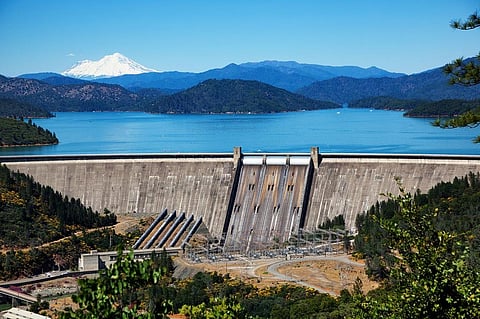

As the United States developed the American West at the beginning of the twentieth century, the federal government constructed hundreds of hydroelectric dams on prominent rivers in the region. Though these dams ruined riverine ecosystems and inundated indigenous land, they also supplied millions of people with affordable renewable energy.
However, a series of record-breaking droughts over the past two decades has dwindled the hydroelectric potential of the region. Inadequate water levels in major rivers leave less water to power the electricity turbines, impacting power production.
This, however, has another serious implication: A dramatic increase in carbon emissions, steered by rigorous ramp-up of fossil fuel power plants.
In addition, heatwaves that frequently precede dry spells worsen emissions by spiking energy demand as people fire up their air conditioners.
Also read: Where are the world’s water stresses?
Researchers from Stanford University recently found that drought in the region dramatically inflated carbon emissions, methane leakage, air pollution and deaths caused by poor air quality.
Over the past two decades, the social and economic cost of these impacts accounted for tens of billions of dollars for 11 Western states, noted the findings of their study published in journal Proceedings of the National Academy of Sciences on July 6, 2023.
Between 2012 and 2016, a drought-induced spike in fossil fuel generation cost California more than $5 billion in damages — more than double the direct economic cost of shifting from cheap hydropower to fossil fuels.
“Our research suggests the impact on greenhouse gas emissions, air pollution and human health could represent a large and unaccounted-for cost of climate change,” said lead study author Minghao Qiu, a postdoctoral scholar in the Stanford Doerr School of Sustainability and Stanford Center for Innovation in Global Health.
In states such as Washington, California and Oregon that depend heavily on hydropower for energy generation, emissions rendered by drought-induced fossil-fuel adoption could account for up to 40 per cent of all greenhouse gas emissions from electricity in future drought years, the researchers pointed out.
Also read: How climate change spurs megadroughts
Recurrent droughts will make it more difficult for the electricity sector to fully decarbonise. Hydro-reliant states will need to seek extra initiatives to achieve net-zero emission goals, they suggested.
“If we want to solve this issue, we need an even greater expansion of renewable energy alongside better energy storage, so we don’t need to tap into fossil fuels as much,” said Qiu. “Ultimately, to limit future warming and the drought risks that come with it, we need to reduce our emissions.”
These damages, like many other climate impacts, frequently span borders. When hydropower runs short in Northwestern states that traditionally export electricity to regional neighbours, communities in neighbouring states also suffer as authorities might ramp up fossil fuel power plants to bridge the demand-supply gap.
“This is not a local story. A climate shock in one place can have serious ramifications for a totally different geographic area due to the interconnected nature of many energy systems,” said Qiu.